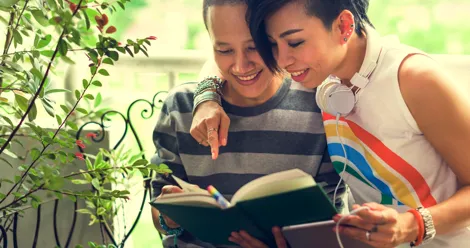
The Queerness of Emma
When I was in college, I took a seminar on the works of Jane Austen. I was thrilled; my shame over not having read her previously was immense. I’d enjoyed both the BBC adaptation and Kiera Knightley-led version of Pride and Prejudice. It’s hard not to identify with Elizabeth Bennett, a headstrong and cantankerous girl who’s secretly a marshmallow. Watching these adaptations and ultimately reading Austen’s original novel, I oscillated wildly between wanting to be Elizabeth and wanting to be Mr. Darcy, the man with whom she falls in love.
Reading Jane Austen when not-straight is kind of frustrating: the women are mostly great, witty and astute, and their inevitably male objects of affection are, well, not. (Yes, even Mr. Darcy). Women who don’t buy into or care about the nonsense of men are Austen’s bread and butter, her lasting legacy—or at least, a very large part of it.
Emma possesses this same nonchalance, but does so with glee. Over at The Atlantic, Annika Neklason encapsulates what makes Emma such a dynamic character: “By virtue of circumstance and personality, she’s romantically independent and intends to stay that way, but she’s fond of conversation, of organizing and attending social events, and of dancing.”
Emma was also the first Austen heroine who I felt—who I knew—was actually queer. (Sorry, Mr. Knightley.) Over and over again, both Austen and Emma herself point out how unlike other girls and women Emma is, how uninterested she is in conventionally feminine activities and behaviors.
From the very beginning of the book, Austen positions Emma as constantly shifting between both masculinity and femininity. In the very first line of the novel, Austen describes Emma as “uniting some of the best blessings of existence.” A few pages later, Emma refers to herself as “a something in between.” Although Emma utters these words in reference to Knightley’s accusation that, as a matchmaker, Emma can either be the “do-nothing” and the “do-all,” Emma’s words provide an apt description for her gender-bending behaviors. Many queer women feel like they are “something in between.”
In one scene, Mr. Knightley explicitly states that Mrs. Weston, Emma’s former governess, learned how to become a wife by living with Emma. “But you were preparing yourself to be an excellent wife all the time you were at Hartfield,” Knightley tells Mrs. Weston. “You were receiving a very good education from [Emma], on the very material matrimonial point of submitting your own will, and doing as you were bid.” The implication here is that Emma, consciously or otherwise, stepped into the role of the husband.
Emma experiences a dearth of feminine influence in her life—her mother had died “too long ago for [Emma] to have more than an indistinct remembrance of her caresses”—and in some cases, she performs femininity in much the same way queer women do. One hilarious example is when Emma uses her baby cousin as a prop to distract Mr. Knightley from scolding her: “She hoped it might rather assist the restoration of friendship, that when he came into the room she had one of the children with her.”
This lack of femininity at least partially explains Emma’s desire to befriend Harriet, who Austen describes as “a girl of seventeen whom Emma knew very well by sight and had long felt an interest in, on account of her beauty.” A few sentences later, Austen more or less repeats this: “[Harriet’s] beauty happened to be of a sort which Emma particularly admired.” At seventeen, I too befriended many girls on account of their beauty. Many of the girls I became friends with when I was younger were girls for whom femininity came easily, whose presence made me feel as though I was inhabiting the world of girlhood.
At one point in the novel, Emma recounts her resolution to remain single to Harriet, an explanation that exemplifies the character’s tendency to exhibit more masculine behavior. Emma says, “My being charming, Harriet, is not quite enough to induce me to marry; I must find other people charming […] I must see somebody very superior to anyone I have seen yet, to be tempted.” Emma refuses to marry because she has not come across a suitable suitor, suggesting that, if she were ever to consider marrying, she would choose her spouse. In this way, Emma both rejects the role of the woman in nineteenth-century courting rituals and embraces the role of the male. During the same conversation with Harriet, Emma states that marriage is not he “way” or her “nature.”
Austen herself referred to Emma as “a heroine whom no one else but myself will much like,” and it’s fairly easy to see why; Emma is a character who not only bucks social convention, but does so with devil-may-care delight. As I was reminded during Pride month last month, our queerness, our deviation from what is considered “conventional” and our degree of freedom from gender norms, is something to be celebrated. As a young queer girl, reading Emma was a revelation.
- Blame Jane Austen for My Fanfiction Addiction
- 5 Contemporary YA Jane Austen Retellings
- Get Lost in Austen: 13 Adaptations for Jane Austen Fans
- Why EMMA is the Worst Jane Austen Novel
- 5 Excellent Jane Austen Comic Book Adaptations
- Giveaway: Jane Austen Penguin Clothbound Editions!
- From Pemberley to Trump Tower: Jane Austen Quotes Meet Trump Tweets
- Literary Tourism: Jane Austen-Themed Destinations
- Don’t Dismiss Jane Austen as a Writer of “Silly Things”









